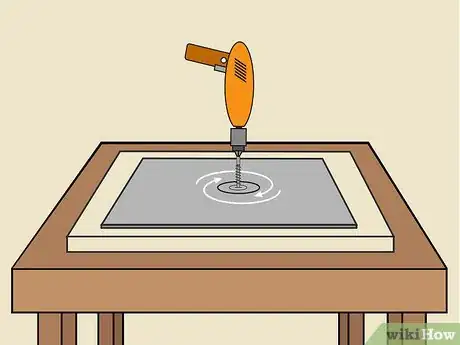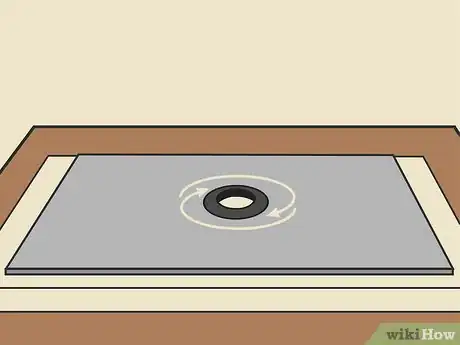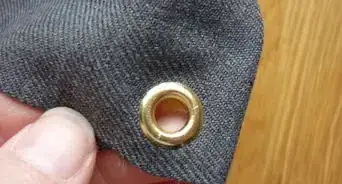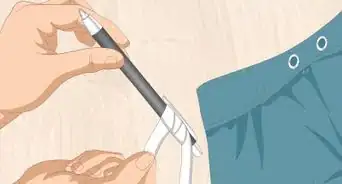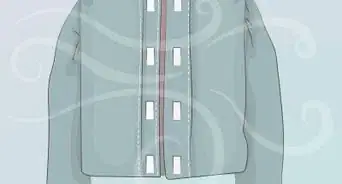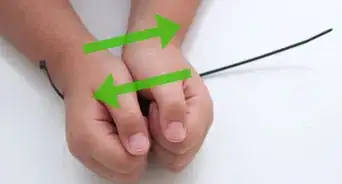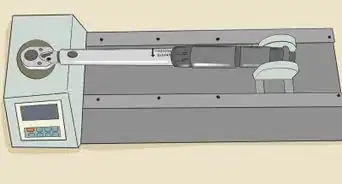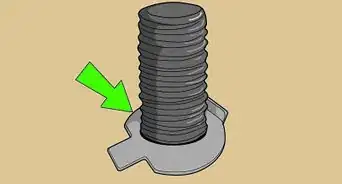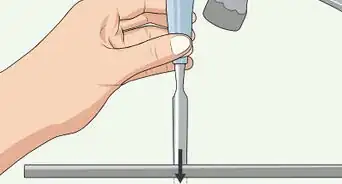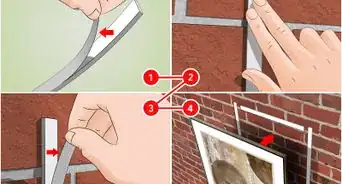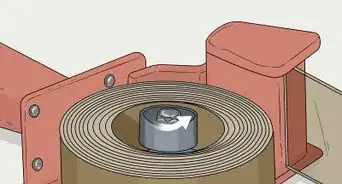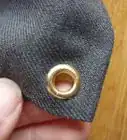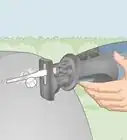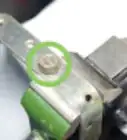This article was co-authored by wikiHow Staff. Our trained team of editors and researchers validate articles for accuracy and comprehensiveness. wikiHow's Content Management Team carefully monitors the work from our editorial staff to ensure that each article is backed by trusted research and meets our high quality standards.
This article has been viewed 214,544 times.
Learn more...
If you're putting together a panel or piece of fabric and there needs to be a hole in it, you'll want to install a grommet. Grommets are small rings that reinforce these holes and protect the items you pass through them, such as electrical wiring. Metal grommets are most common because they're the most durable, but rubber and plastic grommets are best used when you don't want the grommet to have sharp edges. Fortunately, whatever type you're using, installing grommets is a cinch if you have the right tools!
Steps
Inserting Metal Grommets in Fabric
-
1Apply interfacing to your fabric, if you want to make it more durable. Metal grommets can sometimes rip out of fabrics, so applying interfacing to your fabric can help prevent this. Lay your fabric on an ironing board with the “back” or “unseen” side facing up. Lay the fusible side of the interfacing onto the fabric, then place a damp pressing cloth on top of it. Finally, press down on the cloth with a hot iron for 15 seconds.[1]
- The “back” or “unseen” side of the fabric is the side that is not meant to face outward where other people can see it. For example, the inside of a shirt is the “back” or “unseen” side of the shirt's fabric.
- The fusible side of the interfacing is the bumpier side. The non-fusible side is the smooth side.
- Don't glide the hot iron across the interfacing, as this may cause it to be displaced. If you have to iron multiple spots on your piece of fabric, pick up the iron and move it to these other spots instead of gliding it.
- There are 3 types of interfacing available: non-woven, woven, and knit. Each of these types comes in different weight. If you're not sure which type to get for your fabric, use the type that is closest in weight to your fabric.
-
2Mark where you'll install the grommet and place a block underneath it. If you're installing more than 1 grommet, be sure to mark the location of each grommet on your fabric, leaving an equal amount of space between them. Mark the spot with a pencil by tracing the inside circle of the grommet.[2]
- If your grommet kit didn't come with a stabilizing block to place underneath the fabric, a small wooden block will also work.
- Leave about 4.5 inches (11 cm) of space between each individual grommet. Each grommet must be at least 2 inches (5.1 cm) away from the edge of the fabric.
Advertisement -
3Punch a hole in your fabric using a hole cutter and hammer. Place the hole cutter over the mark you made on your fabric, making sure to line it up precisely with the small circle you traced. Once the hole cutter is in place, grip it firmly with 1 hand and hammer it sharply to punch a hole in the fabric. You may need to strike the hole cutter more than once.[3]
- The hole cutter included in most grommet kits is usually just a small metal cylinder with the correct diameter for the grommet.
- Make sure the fabric is flat against the wooden block before you strike the hole cutter.
- If you can't punch straight through with the hole cutter, make a small X in the hole outline you've created with an X-acto or fabric knife and cut the inside of the circle out.[4]
-
4Set the grommet on an anvil, then slide the hole in the fabric over it. Place the anvil on a flat, sturdy work surface first. Slide the fabric hole over the grommet on the anvil so that the top of the grommet sticks all the way out the other side.[5]
- Your grommet kit should include an anvil. If it doesn't, you can make one by cutting a small circular hole into your wooden block. Cut the hole to be just slightly wider than the diameter of the grommet, so that it fits securely in the hole and won't slide out.
-
5Slide a washer over the top of the grommet. Make sure to slide the washer over the grommet with the rounded side up. This washer doesn't have to go all the way down the top of the grommet; it just needs to be secure enough that it won't slide off.[6]
- The washer is sometimes referred to as the “female piece” of the grommet kit.
-
6Use a hammer and setter piece to pound these 2 pieces together. Place the setter piece over the top of the grommet and washer, aligning it with the anvil underneath the fabric. Strike the piece firmly with a hammer, then rotate the setter a quarter turn and strike it again. Continue striking it in this way until the grommet and washer are firmly attached to each other.[7]
- Check your progress after the first 2 hammer strikes. If the pieces don't seem to be “melding” together, you may need to hit them harder.
- Once the pieces are securely attached, the edge of the grommet's top should have rolled back over the inner edge of the washer.
Installing Rubber or Plastic Grommets
-
1Drill the hole you'll insert the grommet into, if necessary. Use a small twist drill bit, about 1⁄8 inch (0.32 cm) big, and a power drill to drill the hole. Drill the hole according to the recommended size for the grommet, as stated in the manufacturer's instructions. Use a handheld deburring tool to smooth the edge of the hole as much as possible before you go to insert the grommet.
- Use as slow a drill speed as possible when you drill the hole, especially if it's a tough metal. This is especially important if you're using a drill bit that's larger than 1⁄8 inch (0.32 cm).
-
2Push 1 side of the grommet through the opening. If you have access to the opposite side of the material, it may help to pull the grommet through or simply to hold it in place. A soft object, such as a plastic soldering aid, can assist in pushing the grommet to fit the hole.[8]
- If you're having trouble bending the grommet, try boiling it. Letting a rubber grommet sit in boiling water for a few minutes makes it much more pliable.
- If the fit is a bit tight, an easy way to install the rubber grommet is to use silicone applied around the outside of the grommet just before pressing it into place. Using a silicone sealant will help keep it in place after the silicone dries too.
-
3Continue pushing the rest of the grommet through the hole. Work all the way around the opening, bending the grommet as required. Don't let up on the pressure until the grommet is securely placed inside the hole.[9]
- Test the grommet by trying to push it out of the hole with your thumb. If it's successfully installed, you shouldn't be able to push it out.
Community Q&A
-
QuestionHow do I drill a 6 mm hole in granite?
 Community AnswerYou can just use a 6 mm drill bit if you have one.
Community AnswerYou can just use a 6 mm drill bit if you have one. -
QuestionHow can I remove a grommet?
 Samuel C. KingCommunity AnswerShove the head of a flat head screwdriver under the edge of the grommet and push up. Continue doing this around the entire circumference of the grommet. Once you've done this, use a pair of pliers to pull the top of the grommet away from the bottom of it.
Samuel C. KingCommunity AnswerShove the head of a flat head screwdriver under the edge of the grommet and push up. Continue doing this around the entire circumference of the grommet. Once you've done this, use a pair of pliers to pull the top of the grommet away from the bottom of it. -
QuestionHow can I increase hole size in an installed grommet by 1/16"? Grommet is 3/8" now. The grommets are at the top of a large premium vinyl banner and holes are too small for snap link clips.
 Samuel C. KingCommunity AnswerIt would probably make more sense for you to remove and then reinstall the grommet. Shove the head of a flat head screwdriver under the edge of the grommet and push up. Continue doing this around the entire circumference of the grommet. Once you've done this, use a pair of pliers to pull the top of the grommet away from the bottom of it.
Samuel C. KingCommunity AnswerIt would probably make more sense for you to remove and then reinstall the grommet. Shove the head of a flat head screwdriver under the edge of the grommet and push up. Continue doing this around the entire circumference of the grommet. Once you've done this, use a pair of pliers to pull the top of the grommet away from the bottom of it.
Warnings
- A basic grommet may provide some protection against dust and splashes, but if you need an air- or watertight seal, strain relief, or electromagnetic shielding, you may need to use a device that is designed specifically for this purpose.⧼thumbs_response⧽
- Sharp sheet metal edges can cut you, cables, or tubing. Be careful when working around them. You should always use a half round/flat mill file, deburring tool, emery cloth or something sharp like the back edge of a utility knife to 'break' (scrape off) the rough edges of the hole or the metal sheet.⧼thumbs_response⧽
Things You'll Need
- Grommet kit
- Hammer or mallet
- Drill
References
- ↑ https://shop.mybluprint.com/sewing/article/using-interfacing/
- ↑ https://sew4home.com/tips-resources/sewing-tips-tricks/how-install-metal-grommets-your-sewing-projects
- ↑ https://www.familyhandyman.com/project/install-a-tarp-grommet/
- ↑ http://www.curbly.com/users/modhomeecteacher/posts/4275-diy-ten-minute-grommet-workshop
- ↑ https://www.familyhandyman.com/project/install-a-tarp-grommet/
- ↑ https://sew4home.com/tips-resources/sewing-tips-tricks/how-install-metal-grommets-your-sewing-projects
- ↑ https://www.familyhandyman.com/project/install-a-tarp-grommet/
- ↑ https://www.youtube.com/watch?v=1WTCGlvl3Rg#t=1m01s
- ↑ https://www.youtube.com/watch?v=1WTCGlvl3Rg#t=1m04s
About This Article
To install grommets in fabric, start by ironing some interfacing to the back of the fabric to help prevent the grommets from ripping out. Then, mark where you want the grommets to go on the fabric, and punch a hole in those spots using a hole cutter and a hammer. Next, place one of the grommets on an anvil, slide one of the holes in the fabric over it, and place a washer over the top of the grommet. Finally, pound the 2 pieces together with a hammer and a setter piece, and repeat with the rest of the grommets. To learn how to install rubber or plastic grommets, scroll down!






